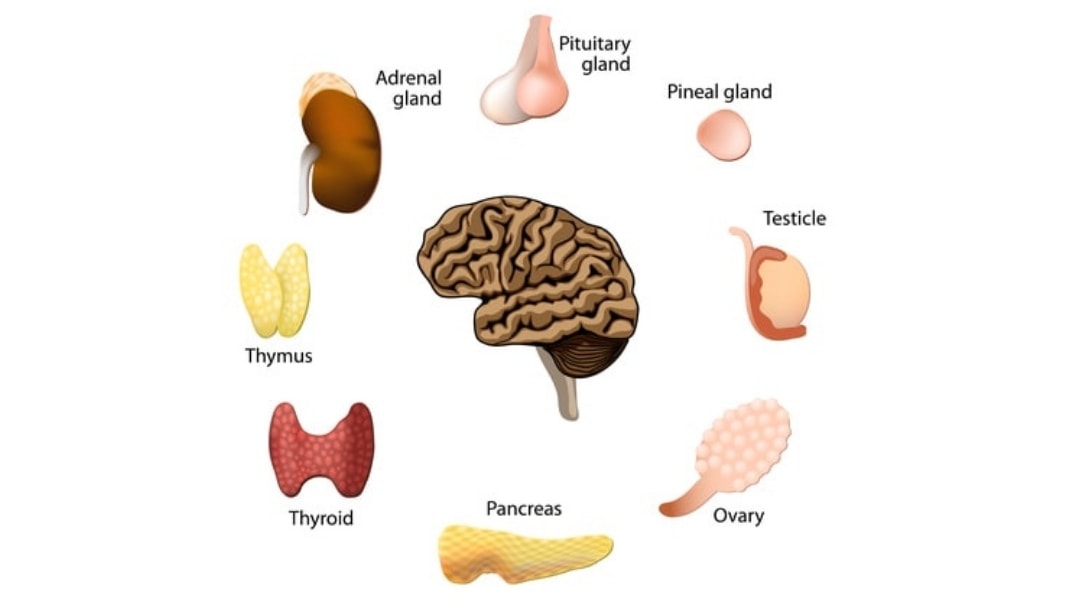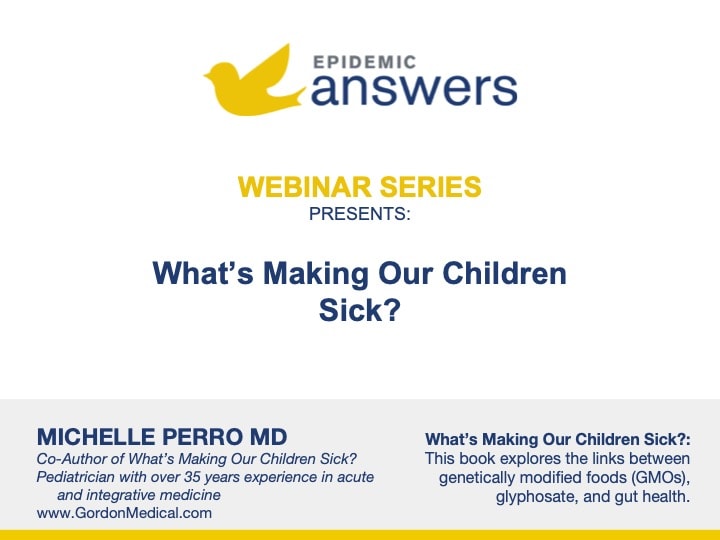Endocrine disruptors have been defined by the National Institute of Environmental Health Sciences as chemicals that may interfere with the body’s endocrine (hormonal) system. They also produce adverse developmental, reproductive, neurological and immune effects on both humans and wildlife. Not only do these insidious toxins discombobulate our entire hormonal system, but we have no idea how their devastating damage is going to affect future generations in every family.
There is a frightening number of chemicals in our environment today that can set off a cascade of unnatural reactions that interfere with the synthesis, transport, binding and actions of hormones.
Impact on Neurodevelopment
Exposure to endocrine disruptors either in utero or during the first two years of life of a child can significantly damage neurodevelopment.
Developmental milestones are reached in the first two years of life when the neurological, immune, nervous and sensory systems are all developing. A child does not fully develop the thymus gland, which protects the immune system, until after two years of age. This means the immune system is much more susceptible to toxic insults.
Toxic insults such as endocrine disruptors can be accumulative and impair the brain at any age, but they are particularly damaging to the developing brain. Once neurodevelopment regresses due to toxic overload, as in the case of autism spectrum disorders, recovery can take a long time, and in many cases may never be attainable.
In addition to the life of a child, there is the stress and burden on families, marriages, siblings, finances, school, society and the list is never ending.
Effects of Endocrine Disruptors
Here are some of the disruptions in our hormonal system when these toxins wreak havoc in our bodies:
- Increasing production of certain hormones
- Decreasing production of other hormones
- Imitating hormones
- Turning one hormone into another
- Interfering with hormone signaling
- Communicating cell death prematurely
- Competing with essential nutrients
- Binding to essential hormones
- Accumulating in organs that produce hormones.
Common Endocrine Disruptors
The twelve worst known endocrine disruptors (the dirty dozen) that should be avoided at all cost are:
- BPA is a chemical used in plastics that imitates estrogen. It is found in the lining of cans of food. Avoid plastics marked with PC for polycarbonate.
- Dioxins are created during industrial processes when chlorine and bromine are burned in the presence of carbon and oxygen. They are powerful carcinogens and can negatively affect the immune and reproductive systems. Meat, fish, milk, eggs and butter are foods most likely to be contaminated.
- Atrazine is a widely used herbicide on the majority of corn crops and is found in drinking water. It is linked to breast cancer, delayed puberty and prostate inflammation. Buy organic produce and get filtered water to avoid this toxin.
- Phthalates are found in plastic food containers, children’ toys, plastic wrap made from PVC, and personal care products and perfumes, as they can:
- Trigger “death-inducing signaling” in testicular cells
- Cause lower sperm count
- Cause less mobile sperm
- Cause birth defects in the male reproductive system
- Cause obesity
- Cause diabetes
- Cause thyroid irregularities
- Perchlorate is a component of rocket fuel often found in our produce and milk. It competes with iodine, thereby causing thyroid hormone imbalances. Balanced thyroid hormones are critical for proper brain and organ development in babies and children. Install a reverse osmosis water filter and increase iodine in your diet to help avoid the effects of this toxin.
- Fire retardants have persistent chemicals known as polybrominated diphenyl ethers or PBDEs. They imitate thyroid hormones and disrupt their activity and can lower IQ. They are found in breast milk, human bodies – even in polar bears. A vacuum clear with a HEPA filter can help cut down on toxic house dust. Avoid reupholstering foam furniture and replacing old carpets.
- Lead harms almost every organ. It disrupts the hormone signaling from the hypothalamus-pituitary- adrenal axis to increase stress. To limit exposure to lead, get rid of old paint and use a reverse-osmosis water filter. Lead is linked to a huge number of health effects such as:
- Permanent brain damage
- Lower IQ
- Hearing loss
- Miscarriages
- Premature births
- Increased blood pressure
- Kidney damage
- Lower levels of sex hormones
- Nervous system problems
- Arsenic is in our food, especially rice, chicken, applesauce and water. It can cause skin, bladder and lung cancer and disrupt the glucocorticoid system that processes carbohydrates and sugars. It is linked to immunosuppression, insulin resistance, osteoporosis, growth retardation and high blood pressure. Use a reverse-osmosis water filter and avoid food with high levels of arsenic.
- Mercury can be airborne from burning coal getting into the air and oceans. Many large fish such as tuna have methylmercury which is toxic to the fetal brain and developing brain. Medicines containing an ethylmercury preservative in the form of thimerosal can have a devastating neurotoxic effect on the brain. To avoid mercury make sure medicines do not have thimerosal, avoid mercury dental amalgams, and eat wild caught smaller fish such mackerel.
- Perfluorinated chemicals (PFCs) chemicals are found in non-stick cookware and are resistant to biodegradation. Exposure has been linked to decreased sperm quality, low birth weight, kidney disease, thyroid disease, and high cholesterol. Avoid using non-stick pans and water-resistant coatings on clothing, furniture and carpets.
- Orgnophosphate pesticides are toxic pesticides that target the nervous system of insects. Studies link exposure to brain development problems, behavioral problems and fertility problems becuase they lower testosterone and alter thyroid hormone levels. Buy organic produce and use organic pesticides.
- Glyco ethers are capable of shrinking testicles and damaging fertility or the unborn child. They are found in solvents, paints, cleaning products, brake fluid and cosmetics. Exposure causes more allergies and asthma in children. Buy healthy cleaning fluids and avoid products with EGBE and DEGME.
Still Looking for Answers?
Visit the Epidemic Answers Practitioner Directory to find a practitioner near you.
Join us inside our online membership community for parents, Healing Together, where you’ll find even more healing resources, expert guidance, and a community to support you every step of your child’s healing journey.
Sources & References
Adams, J.B., et al. Mercury in first-cut baby hair of children with autism versus typically-developing children. Toxicological & Environmental Chemistry. 2007 Jun;70(12):1046-51.
Adams, J.B., et al. Mercury, Lead, and Zinc in Baby Teeth of Children with Autism Versus Controls. Journal of Toxicology and Environmental Health. 2007 Jun;70(12):1046-51.
Alampi, J.D., et al. Gestational Exposure to Toxicants and Autistic Behaviors using Bayesian Quantile Regression. Am J Epedemiol. 2021 Sep 1;190(9):1803-1813.
Mixtures of persistent organic pollutants are found in vital organs of late gestation human fetuses. Chemosphere. 2021 Nov;283:131125.
Braun, J.M., et al. Gestational exposure to endocrine-disrupting chemicals and reciprocal social, repetitive, and stereotypic behaviors in 4- and 5-year-old children: the HOME study. Environ Health Perspect. 2014 May;122(5):513-20.
Cohen, Patricia. Roundup Maker to Pay $10 Billion to Settle Cancer Suits. The New York Times. 24 Jun 2020.
Geier, M.R., et al. The potential importance of steroids in the treatment of autistic spectrum disorders and other disorders involving mercury toxicity. Med Hypotheses. 2005;64(5):946-54.
Gunatilake, S., et al. Glyphosate’s Synergistic Toxicity in Combination with Other Factors as a Cause of Chronic Kidney Disease of Unknown Origin. Int J Environ Res Public Health. 2019 Jul 31;16(15):2734.
Hansen, J.B., et al. Prenatal exposure to bisphenol A and autistic- and ADHD-related symptoms in children aged 2 and5 years from the Odense Child Cohort. Environ Health. 2021 Mar 12;20(1):24.
Harley, K.G., et al. Changes in Latina Women’s Exposure to Cleaning Chemicals Associated with Switching from Conventional to “Green” Household Cleaning Products: The LUCIR Intervention Study. Environ Health Perspect. 2021 Sep;129(9):97001.
Hauser, P., et al. Resistance to thyroid hormone: implications for neurodevelopmental research on the effects of thyroid hormone disruptors.
Toxicol Ind Health. 1998 Jan-Apr;14(1-2):85-101.
Hertz-Picciotto, I., et al. Polybrominated diphenyl ethers in relation to autism and developmental delay: a case-control study. Environ Health. 2011 Jan 5;10(1):1.
Hinhumpatch, P., et al. Oxidative DNA damage and repair in children exposed to low levels of arsenic in utero and during early childhood: application of salivary and urinary biomarkers. Toxicol Appl Pharmacol. 2013;273(3):569-79.
Holmes, A., et al. Reduced Levels of Mercury in First Baby Haircuts of Autistic Children. International Journal of Toxicology. Jul-Aug 2003;22(4):277-85.
Jafari, M.H., et al. The Relationship Between the Level of Copper, Lead, Mercury and Autism Disorders: A Meta-Analysis. Pediatric Health, Medicine and Therapeutics. 21 Sep 2020(11):369—378.
Jafari, T., et al. The association between mercury levels and autism spectrum disorders: A systematic review and meta-analysis. J Trace Elem Med Biol. 2017 Dec;44:289-297.
Julvez, J., et al. Early life multiple exposures and child cognitive function: A multi-centric birth cohort study in six European countries. Environ Pollut. 2021 Sep 1;284:117404.
Kern, J.K., et al. A biomarker of mercury body-burden correlated with diagnostic domain specific clinical symptoms of autism spectrum disorder. Biometals. 2010;23(6):1043-51.
Konkel, L. Phthalates and Autistic Traits: Exploring the Association between Prenatal Exposures and Child Behavior. Environ Health Perspec. 2020 Oct;128(10):104001.
Landrigan, P.J., et al. Children’s vulnerability to toxic chemicals: a challenge and opportunity to strengthen health and environmental policy. Health Aff. (Millwood). 2011 May;30(5):842-50.
Lombardi, C., et al. Residential proximity to pesticide application as a risk factor for childhood central nervous system tumors. Environ Res. 2021 Jun;197:111078.
Lyall, K., et al. Prenatal Serum Concentrations of Brominated Flame Retardants and Autism Spectrum Disorder and Intellectual Disability in the Early Markers of Autism Study: A Population-Based Case-Control Study in California. Environ Health Perspect. 2017 Aug 30;125(8):087023.
Messer, A. Mini-review: polybrominated diphenyl ether (PBDE) flame retardants as potential autism risk factors. Physiol Behav. 2010 Jun 1;100(3):245-9.
Napoli, E., et al. Toxicity of the flame-retardant BDE-49 on brain mitochondria and neuronal progenitor striatal cells enhanced by a PTEN-deficient background. Toxicol Sci. 2013 Mar;132(1):196-210.
Napolitano, G., et al. Is zinc deficiency a cause of subclinical hypothyroidism in Down syndrome? Ann Genet. 1990;33(1):9-15.
Palmer, R.F., et al. Proximity to point sources of environmental mercury release as a predictor of autism prevalence. Health and Place. 2009 Mar;15(1):18-24.
Peltier, M.R., et al. Maternal Hypothyroidism Increases the Risk of Attention-Deficit Hyperactivity Disorder in the Offspring. Am J Perinat. 2020 Oct 21.
Samsel, A., et al. Glyphosate, pathways to modern diseases II: Celiac sprue and gluten intolerance. Interdiscip Toxicol. 2013 Dec;6(4):159-84.
Samsel, A., et al. Glyphosate, pathways to modern diseases III: Manganese, neurological diseases, and associated pathologies. Surg Neurol Int. 2015 Mar 24;6:45.
Samsel, A, et al. Glyphosate’s suppression of cytochrome P450 enzymes and amino acid biosynthesis by the gut microbiome: Pathways to modern diseases. Entropy. 2013;15:1416–1463.
Venâncio, P., et al. Anti-N-methyl-D-aspartate receptor encephalitis with positive serum antithyroid antibodies, IgM antibodies against mycoplasma pneumoniae and human herpesvirus 7 PCR in the CSF. Pediatr Infect Dis J. 2014 Aug;33(8):882-3.
Wang, H.L., et al. Case-Control Study of Blood Lead Levels and Attention Deficit Hyperactivity Disorder in Chinese Children. Environmental Health Perspectives. 2008 Oct;116(10):1401-6.
Watt, T., et al. Is Thyroid Autoimmunity per se a Determinant of Quality of Life in Patients with Autoimmune Hypothyroidism? Eur Thyroid J. 2012;1(3):186-92.
Wong, S., et al. Autism, Mitochondria and Polybrominated Diphenyl Ether Exposure. CNS Neurol Disord Drug Targets. 2016;15(5):614-23.
Xu, C.L., et al. Anti-N-methyl-D-aspartate receptor encephalitis with serum anti-thyroid antibodies and IgM antibodies against Epstein-Barr virus viral capsid antigen: a case report and one year follow-up. BMC Neurol. 2011 Nov 29;11:149.
Resources
Articles
The Environmental Working Group. Body Burden: The Pollution in Newborns. 14 Jul 2005.
Swan, Shanna, et al. Reproductive Problems in Both Men and Women Are Rising at an Alarming Rate: A likely culprit is hormone-disrupting chemicals. Scientific American, 16 Mar 2021.
Books
Hong, Maria Rickert. Almost Autism: Recovering Children from Sensory Processing Disorder, A Reference for Parents and Practitioners. 2014.
Markley, Lisa, et al. The Essential Thyroid Cookbook: Over 100 Nourishing Recipes for Thriving with Hypothyroidism and Hashimoto’s. Blue Wheel Press, 2017.
Perro, Michelle, et al. What’s Making Our Children Sick?: How Industrial Food Is Causing an Epidemic of Chronic Illness, and What Parents (and Doctors) Can Do About It. Chelsea Green Publishing, 2017.
Rogers, Sherry. Detoxify or Die. Prestige Publishing, 2002.
Wachter, Kenneth W., et al. Offspring: Human Fertility Behavior in Biodemographic Perspective. National Academy of Sciences, 2003.
Videos
A Global Fertility Crisis – Dr. Shanna Swan




